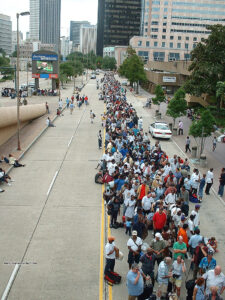Remembering Hurricane Katrina Ten Years Later
You’ve likely heard a number of tenth anniversary stories regarding Katrina, the hurricane that ravaged the Gulf Coast in 2005. Here is a story looking back on the storm and the effects it has on the Gulf Coast region and the people that made it through the storm. (And make sure you click on the photo below to access a photo essay with more images and explanation about how the storm affected the people of New Orleans.)
The Storm
It started as a tropical storm over the Bahamas on August 23, 2005. The storm strengthened into a category 5 hurricane (as determined by National Weather Service) over the waters of the Gulf of Mexico but was then downgraded to a category 3 before reaching landfall on August 29. Even though the storm’s intensity had weakened as it approached land, its great size was part of the reason that it caused such a devastating impact. Coastal communities ranging from Texas to Central Florida were affected, but the areas that suffered the most damage were the beach towns of Mississippi and New Orleans, Louisiana.
New Orleans and the Levees
What caused the biggest destruction in New Orleans was not the hurricane itself, but the fact that the city’s levee system failed, flooding up to 80 percent of New Orleans. While New Orleans is more than 100 miles from the Gulf of Mexico, it is located on the banks of the Mississippi River and surrounds Lake Pontchartrain.
In 1965, Congress passed the Flood Control Act in response to the devastation caused by Hurricane Betsy. This authorized the U.S. Army to design and construct surge protections throughout the southeastern part of the United States, included the levee system in New Orleans. The construction did not begin until 1985. It was projected to take 13 years, but by the time Hurricane Katrina hit the city, the project was only 60 to 90 percent completed. There were more than 50 reported breaches to the levees.
The Damage and the Blame
In anticipation for the storm, New Orleans mayor Ray Nagin issued the city’s first-ever mandatory evacuation. However, the city’s population is one of the poorest in the country and many were not able to leave the homes. More than 20,000 people took refuge in the city’s Superdome sports stadium as a “shelter of last resort.” When the hurricane made landfall, more than 2,000 people died. The city’s Lower Ninth Ward was hit the hardest.
After the failure of the city’s surge protection system, both local and federal government received the most blame for the chaos that ensued in the aftermath. Mayor Nagin was criticized for waiting too long to issue his evacuating order and for not having an effective plan in place that provided safe and sanity measures. The Federal Emergency Management Agency (FEMA) was also heavily criticized, first for its delayed response to the disaster, and then for an ongoing series of mismanaged recovery attempts. FEMA director, Michael Brown was ultimately fired.
The Recovery and Lasting Impact
Ten years later, more than one million people from the Central Gulf Coast region are permanently relocated to other locations across the United States. Recovery efforts have been slow, but there have been many signs of progress in the region. On the tenth anniversary, there were many events held throughout New Orleans, to remember those who were lost, reflect on what happened, and to celebrate the resiliency of the people.


